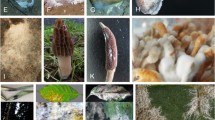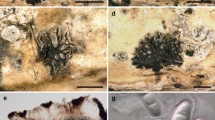Summary
Certain chemicals are selectively toxic to specific groups of fungi. For example, benzimidazoles and thiophanates are selectively toxic to Ascomycotina and Deuteromycotina, oxathiins are selectively toxic to Basidiomycotina, and pyrimidines, polyenes, and polyoxins are toxic to many fungi but not Mastigomycotina. Chemicals selectively toxic to Mastigomycotina include fenaminosulf and prothiocarb. Such chemicals contribute to fungal taxonomy in several ways. Incorporated into isolation media they facilitate the recovery of specific groups of fungi from natural habitats. In some cases the distinctive response of a fungus to a specific chemical facilitates identification of the fungus. Arrangements based on sensitivity to selective fungitoxicants often match classifications based on morphological characters. Selectivity data then provide opportunities to assess the naturalness of established or experimental classifications, to demonstrate the predictive power of classifications or to show the ability of alternative classifications to accommodate apparent exceptions. Selective fungitoxicants also contribute to chemotaxonomy of fungi in two major ways. Fungi can be partitioned into groups on the basis of their responses to an external chemical and research on the mechanisms of action of selective fungitoxicants provides information on the comparative biochemistry of fungi.
Similar content being viewed by others
Literature Cited
Ahmadjian, V. andM. E. Hale (Eds.). 1973. The Lichens. Academic Press, New York.
Ainsworth, G. C., F. K. Sparrow andA. S. Sussman (Eds.). 1973a. The Fungi. An Advanced Treatise. Vol. IVA. Academic Press, New York.
——— (Eds.). 1973b. The Fungi. An Advanced Treatise. Vol. IVB. Academic Press, New York.
Albert, A. 1963. Correlations between microbiological morphology and the chemistry of biocides. Adv. Appl. Microbiol.5: 1–50.
Barron, G. L. 1968. The Genera of Hyphomycetes from Soil. Williams and Wilkins Co., Baltimore.
Bartnicki-Garcia, S. 1968. Cell wall chemistry, morphogenesis, and taxonomy of fungi. Annu. Rev. Microbiol.22: 87–108.
Bollen, G. J. 1972. A comparison of thein vitro antifungal spectra of thiophanates and benomyl. Neth. J. Pl. Path.78: 55–64.
— andA. Fuchs. 1970. On the specificity of thein vitro andin vivo antifungal activity of benomyl. Neth. J. Pl. Path.76: 299–312.
Bolton, A. T. andA. G. Donaldson. 1972. Variability inFusarium solani f.pisi andF. oxysporum f.pisi. Can. J. Plant Sci.52: 189–196.
Buchanan, R. E. andN. E. Gibbons (Eds.). 1974. Bergey’s Manual of Determinative Bacteriology. 8th Edition. Williams and Wilkins Co., Baltimore.
Byford, W. J. 1963.Pleospora bjoerlingii nom. nov. Trans. Brit. Mycol. Soc.46: 614.
Davidse, L. C. 1973. Antimitotic activity of methyl benzimidazol-2-yl carbamate (MBC) inAspergillus nidulans. Pestic. Biochem. Biophys.3: 317–325.
—. 1977. Mode of action, selectivity and mutagenicity of benzimidazole compounds. Neth. J. Pl. Path.83 (Suppl. 1): 135–144.
— andW. Flach. 1977. Differential binding of methyl benzimidazol-2-yl carbamate to fungal tubulin as a mechanism of resistance to this antimitotic agent in mutant strainsof Aspergillus nidulans. J. Cell Biol.72: 174–193.
Dekker, J. 1977. Effect of fungicides on nucleic acid synthesis and nuclear function. pp. 365–398In Antifungal Compounds. Vol. 2. Edited by M. R. Siegel and H. D. Sisler. Marcel Dekker Inc., New York.
Eckert, J. W. andM. J. Kolbezen. 1977. Influence of formulation and application method on the effectiveness of benzimidazole fungicides for controlling postharvest diseases of citrus fruits. Neth. J. Pl. Path.83 (Suppl. 1): 343–352.
Edgington, L. V. andG. L. Barron. 1967. Fungitoxic spectrum of oxathiin compounds. Phytopathology 57: 1256–1257.
—,K. L. Khew andG. L. Barron. 1971. Fungitoxic spectrum of benzimidazole compounds. Phytopathology61: 42–44.
—,G. S. Walton andP. M. Miller. 1966. Fungicide selective for Basidiomycetes. Science153: 307–308.
Fennell, D. I. 1973. Plectomycetes; Eurotiales. pp. 45–68In The Fungi. An Advanced Treatise. Vol. IVA. Edited by G. C. Ainsworth, F. K. Sparrow, and A. S. Sussman. Academic Press, New York.
Fuchs, A. (Ed.). 1977. Internal Therapy of Plants. Proc. Int. Symp. 1976. Wageningen. Neth. J. PI. Path.83 (Suppl. 1).
Gibbs, R. J. 1974. Chemotaxonomy of Flowering Plants. McGill-Queen’s University Press, Montreal.
Hall, R. 1969. Molecular approaches to taxonomy of fungi. Bot. Rev.35: 285–304.
—. 1973. Electrophoretic protein profiles as criteria in the taxonomy of fungi and algae. Bull. Torrey Bot. Club100: 253–259.
—. 1975. Differential sensitivity ofVerticillium dahliae, V. albo-atrum andV. nigrescens to benomyl. Can. J. Bot.53: 452–455.
Hamilton-Miller, J. M. T. 1974. Fungal sterols and the mode of action of the polyene antibiotics. Adv. Appl. Microbiol.17: 109–134.
Harborne, J. B., D. Boulter andB. L. Turner (Eds.). 1971. Chemotaxonomy of the Leguminosae. Academic Press, New York.
Hendrix, J. W. 1977. Sterols and other membrane lipids of Oomycetes. Abstracts 2nd Int. Mycol. Cong. p. 280.
Hori, M., K. Kakiki and T. Misato. 1977. Mode of action of polyoxins. Abstracts 2nd Int. Mycol. Cong. p. 307.
Hughes, S. J. 1953. Conidiophores, conidia and classification. Can. J. Bot.31: 577–659.
Kaars Sijpesteijn, A. 1972. Effects on fungal pathogens, pp. 132–155In Systemic Fungicides. Edited by R. W. Marsh. Longman, London.
—. 1977. Effects on fungal pathogens, pp. 131–159In Systemic Fungicides. 2nd Edition. Edited by R. W. Marsh. Longman, New York.
—,H. M. Dekhuijzen andJ. W. Vonk. 1977. Biological conversion of fungicides in plants and microorganisms. pp. 91–147In Antifungal Compounds. Vol. 2. Edited by M. R. Siegel and H. D. Sisler. Marcel Dekker Inc., New York.
Kendrick, B. (Ed.). 1971. Taxonomy of Fungi Imperfecti. Univ. Toronto Press, Toronto.
Kreutzer, W. A. 1963. Selective toxicity of chemicals to soil microorganisms. Annu. Rev. Phytopathol.1: 101–126.
Lodder, J. (Ed.). 1970. The Yeasts. North-Holland Pub. Co., Amsterdam.
Lyr, H. 1977. Mechanism of action of fungicides. pp. 239–261In Plant Disease. An Advanced Treatise. Vol. I. Edited by J. G. Horsfall and E. B. Cowling. Academic Press, New York.
Marsh, R. W. (Ed.). 1977. Systemic Fungicides. 2nd Edition. Longman, New York.
Martin, R. 1978. Fungitoxicity and translocation of the systemic fungicide α-butyl-α-phenyl-1H-imidazole-1-propanenitrile (RH2161). M.Sc. Thesis, Univ. Guelph.
McCorkindale, N. J., S. A. Hutchinson, B. A. Pursey, W. T. Scott andR. Wheeler. 1969. A comparison of the types of sterol found in species of the Saprolegniales and Leptomitales with those found in some other Phycomycetes. Phytochemistry8: 861–867.
Masago, H., M. Yoshikawa, M. Fukada andN. Nakanishi. 1977. Selective inhibition ofPythium spp. on a medium for direct isolation ofPhytophthora spp. from soils and plants. Phytopathology67: 425–428.
Misato, T. andK. Kakiki. 1977. Inhibition of fungal cell wall synthesis and cell membrane function. pp. 277–300In Antifungal Compounds. Vol. 2. Edited by M. R. Siegel and H. D. Sisler. Marcel Dekker Inc., New York.
Nicholson, D. S. 1974. The selective effects of benomyl on various species ofFusarium. M.Sc. Thesis, Univ. Guelph.
Paulus, A. O., J. Nelson, M. Snyder andJ. Gafney. 1977. Downy mildew of lettuce controlled by systemic fungicide. California Agriculture31: 9.
Ragan, M. A. andD. J. Chapman. 1978. A Biochemical Phylogeny of the Protists. Academic Press, New York.
Ragsdale, N. N. 1977. Inhibitors of lipid synthesis. pp. 333–363In Antifungal Compounds. Vol. 2. Edited by M. R. Siegel and H. D. Sisler. Marcel Dekker Inc., New York.
Richardson, L. T. 1973. Adaptive tolerance ofFusarium solani to benzimidazole derivativesin vitro. Can. J. Bot.51: 1725–1732.
Siegel, M. R. andH. D. Sisler (Eds.). 1977. Antifungal Compounds. Vol. 2. Marcel Dekker Inc., New York.
Smith, P. M. 1976. The Chemotaxonomy of Plants. E. Arnold, London.
Subramanian, C. V. 1962. The classification of the Hyphomycetes. Bull. Bot. Surv. India4: 249–259.
Sutton, B. C. 1973. Coelomycetes. pp. 513–582In The Fungi. An Advanced Treatise. Vol. IVA. Edited by G. C. Ainsworth, F. K. Sparrow and A. S. Sussman. Academic Press, New York.
Tichelaar, G. M. 1974. The use of thiophanate-methyl for distinguishing between twoPhoma varieties causing gangrene of potatoes. Neth. J. Pl. Path.80: 169–170.
Tsao, P. H. 1970. Selective media for isolation of pathogenic fungi. Annu. Rev. Phytopathol.8: 157–186.
— andS. O. Guy. 1977. Inhibition ofMortierella andPythium in aPhytophthora-isolation medium containing hymexazol. Phytopathology67: 796–801.
Weete, J. D. 1974. Fungal Lipid Biochemistry. Plenum Press, New York.
Woodcock, D. 1977a. Chemical structure and fungicide selectivity. Neth. J. Pl. Path.83 (Suppl. 1): 27–37.
—. 1977b. Nonbiological conversions of fungicides. pp. 209–249In Antifungal Compounds. Vol. 2. Edited by M. R. Siegel and H. D. Sisler. Marcel Dekker Inc., New York.
Author information
Authors and Affiliations
Rights and permissions
About this article
Cite this article
Hall, R. Fungitoxicants and fungal taxonomy. Bot. Rev 45, 1–14 (1979). https://doi.org/10.1007/BF02869950
Issue Date:
DOI: https://doi.org/10.1007/BF02869950




